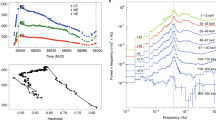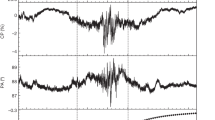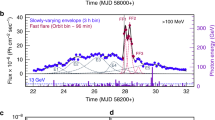Abstract
Many bright X-ray sources were recently found to undergo quasi-periodic oscillations1–4. None of the sources is an X-ray pulsar which indicates that the accreting neutron stars have no magnetos-pheres. Most neutron star models have radii smaller than 3 Schwar-zschild radii5, Between 69% and 86% of the accretion energy is liberated when matter falls from the marginally stable orbit with a radius rms = 3rSch onto the neutron star surface6. The accretion flow through rms is known to be complicated, and a steady-state flow may not be possible when the viscosity parameter α > αcr≈ 0.037,8. Here I suggest that the unsteady flow would make the boundary-layer luminosity variable, possibly giving rise to the X-ray quasi-periodic oscillation (QPO) phenomenon.
This is a preview of subscription content, access via your institution
Access options
Subscribe to this journal
Receive 51 print issues and online access
$199.00 per year
only $3.90 per issue
Buy this article
- Purchase on Springer Link
- Instant access to full article PDF
Prices may be subject to local taxes which are calculated during checkout
Similar content being viewed by others
References
1. Van der KJis, M. et al. IAU Circ. No. 4043 (1985). 2. Van der Klis, M. Nature 316, 225–230 (1985). 3. Lewin, W. H. G. & Van Paradijs, J. Comments Astrophys. 11, 127–135 (1986). 4. Lewin, W. H. G. The Physics of Accretion onto Compact Objects (eds Mason, K. O., Watson, M. G. & Whites, N. E.) 177–194 (Berlin, 1986). 5. Kluzniak, W. & Wagoner, R. V. Astrophys. J. 297, 548–554 (1985). 6. Syanyaev, R. A. & Shakura, N. I. Pis'ma Astr. Zh. 12, 286–292 (1986). 7. Muchotrzeb, B. Acta. Astr. 33, 79–87 (1983). 8. Muchotrzeb–Czerny, B. Acta Ast. 36, 1–17 (1986). 9. Novikov, I. & Thorne, K. S. in Black Holes (eds DeWitt, B. & De Witt, C.) 343–450 (Gordon & Breach, New York, 1973). 10. Kozlowski, M., Jaroszynski, M. & Abramowicz, M. A. Astr. Astrophys. 63, 209–220 (1978). 11. Abramowicz, M. A., Jaroszynski, M. & Sikora, M. Astr. Astrophys. 63, 221–224 (1978). 12. Liang, E. P. T. & Thomspon, K. A. Astrophys. J. 240, 271–274 (1980). 13. Muchotrzeb, B., and Paczyriski, B. Acta Astr. 32, 1–11 (1982). 14. Loska, Z. Acta Astr. 32, 13–24 (1982). 15. Matsumoto, R., Kato, S., Fukue, J. & Okazaki, A. T. Publs. Astr. Soc. Japan 36,71–85 (1984). 16. Pringle, J. E. A Rev. Astr. Astrophys. 19, 137–162 (1981). 17. Joss, P. C. & Rappaport, S. A. A. Rev. Astr. Astrophys. 22, 537–592 (1984). 18. Alpar, M. A. & Shaham, J. Nature 316, 239–241 (1985). 19. Hameary, J. M., King, A. R. & Lasota, J. P. Nature 317, 597–598 (1985). 20. Lamb, F. K., Shibazaki, N., Alpar, M. A. & Shaham, J. Nature 317, 681–687 (1985). 21. Boyle, C. B., Fabian, A. C. & Guilbert, P. W. Nature 319, 648–649 (1986). 22. Alpar, M. A. Man. Not. R. astr. Soc. 223, 469–478 (1986). 23. Lewin, W. G. H. & Joss, P. C. in: Accretion Driven Stellar X–ray Sources, (eds Lewin, W. H. G. & van den Heuve, E. P. J.) 41–65 (Cambridge University Press, 1983).
Author information
Authors and Affiliations
Rights and permissions
About this article
Cite this article
Paczyński, B. Possible relation between the X-ray QPO phenomenon and general relativity. Nature 327, 303–304 (1987). https://doi.org/10.1038/327303a0
Received:
Accepted:
Issue Date:
DOI: https://doi.org/10.1038/327303a0
This article is cited by
-
An analytical study on the multi-critical behaviour and related bifurcation phenomena for relativistic black hole accretion
General Relativity and Gravitation (2012)
-
Resonant Oscillations of Accretion Flow and Khz QPOS
Astrophysics and Space Science (2005)
-
Disk luminosity and angular momentum for accreting, weak field neutron stars in the ‘Slow’ rotation approximation
Journal of Astrophysics and Astronomy (1995)
-
Role of general relativity in accretion disk dynamics
Pramana (1991)
-
Plasma disks around compact objects
Astrophysics and Space Science (1989)
Comments
By submitting a comment you agree to abide by our Terms and Community Guidelines. If you find something abusive or that does not comply with our terms or guidelines please flag it as inappropriate.



